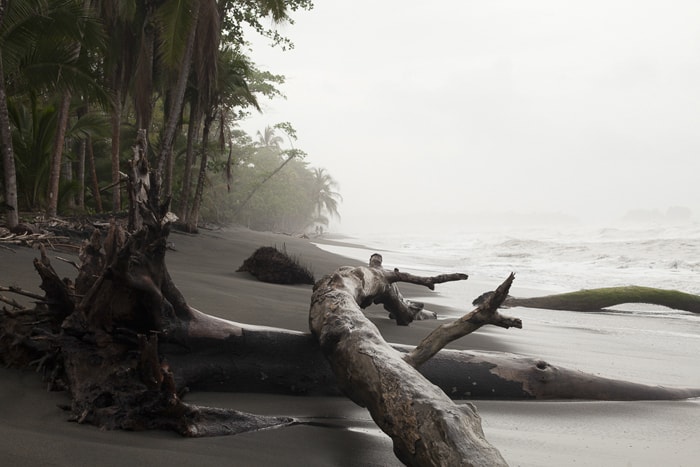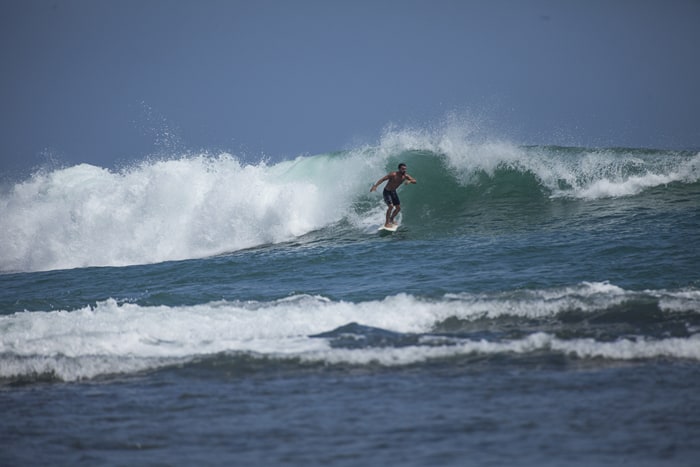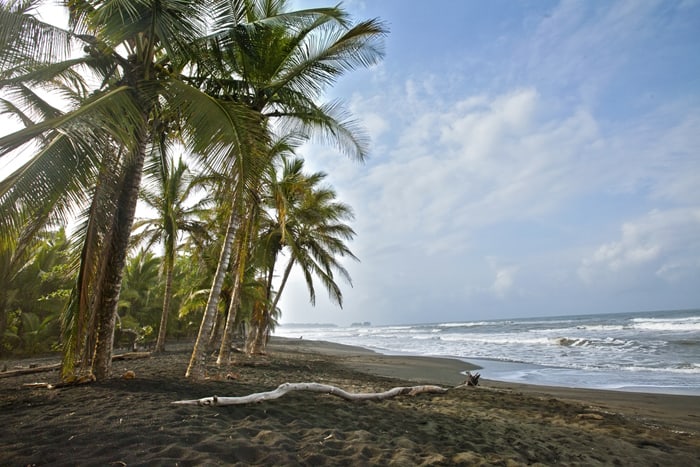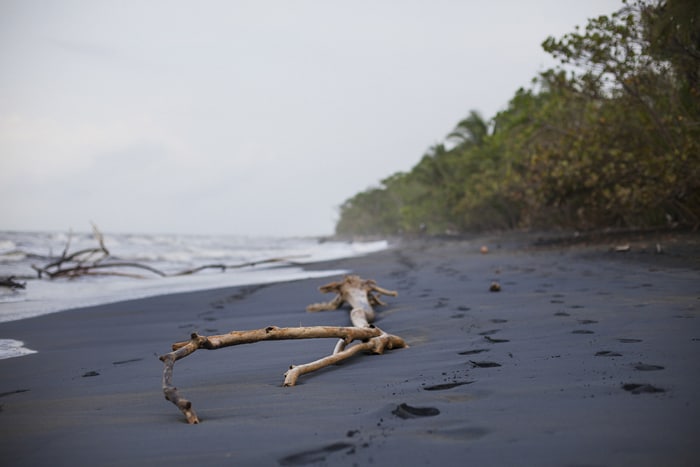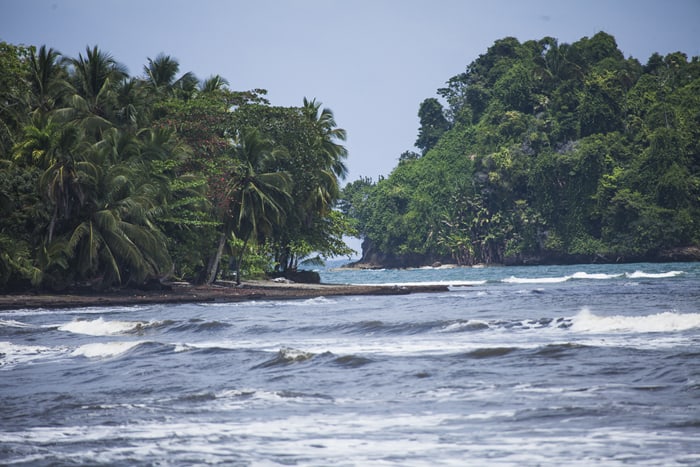We were driving up a hill, in a jungle in the southernmost part of Costa Rica’s Caribbean coast. My hands reached from within the car to the leaves on towering trees. Not satisfied, I poked my head out to get a better view of where we were heading. Surrounded by high walls of impenetrable forest, there was barely enough room for the ribbon of road we drove on. Sunshine fell onto my face and danced on my arms through the openings in the canopy.
Then my eyes caught a movement, and with a shiver I pulled my hand back into the car. Matching almost the size of my hand, there were webs on the trees next to my face, filled with banana spiders.
I showed Diego, the son of the family I was traveling with. He smiled and shrugged. “It’s the jungle.” He said. “don’t put your hand out.”
These banana spiders were golden silk orb weavers, whose venom is harmful but not lethal to humans, unlike that of its deadly cousin the Brazilian wandering spider.
We had left the shops and reggae beats of Puerto Viejo far behind for this venture into the wilderness. Now we were surrounded by ficus trees draped in vines, orchids and moss, and the road was getting rough. I realized we would have to slow down to avoid damaging the car. The farther we went, the more banana spider webs we saw. My hands remained in the vehicle this time.
“Are you sure this is the only way there?” I asked, more curious than worried. I was drawn to anything that was hard to reach, and the destination became more anticipated as the road turned deeper into the woods. The green on the trees glowed and was drenched in wet heavy drops. Messy plants and roots crept back out onto the road behind us, ready to take back their land.
When the trees cleared, hills turned to curves on a paved road. We moved past banana plantations southwards. Our destination: the Gandoca-Manzanillo National Wildlife Refuge.
Our accommodation was on the refuge in a little shared house cabin called Albergue Kániki. The seaside cabin is run by the family of Roberto Serrano Ramirez and Rita Calderón Quiros. They gave us one of the spare rooms with two bunk beds covered with mosquito nets. After placing our stuff on the bunks, we headed outside to explore the water.
The Gandoca-Manzanillo refuge opened in 1985 and covers much of the southern Caribbean coast. It is located in the canton of Talamanca in the province in Limón on the very southeastern tip of the country, just across from Panama. It’s a refuge that protects a lush and biodiverse ecosystem, home to sloths, turtles, tapirs, snakes, frogs and around 360 species of birds, including toucans, owls, eagles and hummingbirds.
I stepped out onto the vast open beach, with its distinctive dark sand, and saw rows of waves taking turns at washing the shore.
My first impression of the water was that it was a dark, sedimented color that swirled in the waves. It wasn’t the famous blue I soon learned came from neighboring beaches like Punta Uva, Manzanillo and Cahuita.
“Where are all the people?” I thought to myself.
It was a wilderness beach. My feet sank deep into the sand, making it difficult to walk. The tide rose high to wash away any footprints I left. The humidity mixed with salt made the air hazy, misty and warm.
Gandoca belongs to nature, not people. The beaches are nesting grounds to a few species of turtles including hawksbill, green and leatherback turtles.
Sometimes manatees are spotted in the lagoon. and this refuge is known for its red mangroves. Just a bit past the lagoon was the Sixaola River, the border of Panama. We crossed our way to the lagoon, accompanied by the son of our hosts.
Our young guide ran eagerly, whistling to horses that walked freely along the beach. He told me he wanted to study birds in Brazil one day.
We passed a few manta rays washed up on the beach. I continued to be most surprised by the color of the water, and the sediments that stirred within it. When I dove into the water, little water bug creatures I had never seen clung to my skin and pinched, letting go when I rose above the water.
“Cristian, why are the waves full of sediment?” I asked.
I was told that there are two sedimentary environments here. Some think the sediments are old remains of coral, while others say the sediment is part of the runoff in nearby creeks and lagoons.
The next day, after a breakfast of yucca bread and coffee, we set out for the hike to Punta Mona. In the distance I saw the curved beach leading out to a point, covered in palm trees, and facing it was an island. “The point of the beach is Punta Mona,” Diego said.
We walked along the black sand at low tide. The beach was larger than last night. Trees pushed their way out onto the beach. I climbed over the trunks, and the crabs crawled away when I approached. The logs were stained and slippery from the tide. I was greeted again by banana spiders in the branches above. I felt the urge to swim out to the island, but the waves were too strong. Finally I came to a cliff and knew I couldn’t continue without hitting rocks.
After hours of hiking north, we made our way back toward camp. As the light got dimmer and the sun disappeared behind the trees, a full moon rose over the ocean. The sediment and the waves had a misty, hazy, salted smell. The two horses we’d seen heading south toward the Sixaola River were on their way back. They slowed down, and then sped up to a canter to pass.
Gandoca reminds us that beaches are natural habitats and not always ones that make us comfortable. But when you get away from commercialized areas and into a remote spot like this, you’ll find a wild beauty that is extraordinary.
IF YOU GO
From Puerto Viejo, drive south along the coastal road until it ends in Manzanillo. Several trails lead into the refuge from there. The refuge is mainly for conservation and accommodations are few, though neighboring cities of Puerto Viejo and Cahuita offer many hospitality options.

